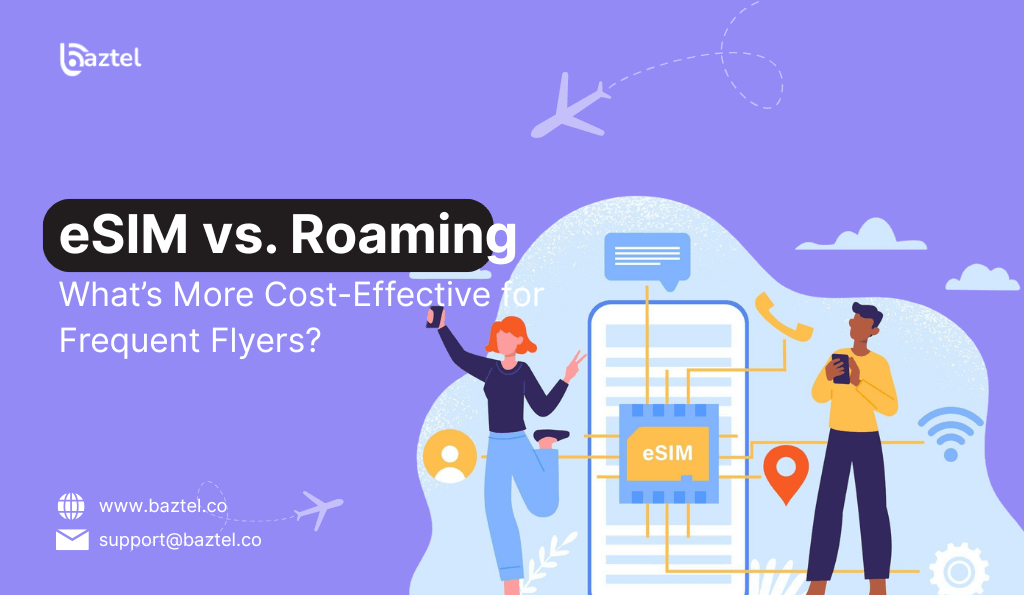If you travel often, you already know the hidden costs that come with it — not just flights and hotels, but also staying online in each country. This article addresses the roaming vs eSIM difference, helping you understand which option is more cost-effective and convenient for your travel needs.
This guide is for frequent flyers and international travelers who want to understand the key differences between roaming and eSIM, so they can make informed choices and avoid unnecessary costs. Understanding these options is crucial for maximizing cost savings and maintaining control over your connectivity while abroad.
Many flyers still stick to international roaming by default. It feels easy. You switch on your phone, and it just works. But then comes the bill — packed with daily charges, surprise deductions, and confusing currency conversions. Roaming charges can be significantly higher than expected because traditional roaming relies on your home network and agreements with foreign carriers, often resulting in a much higher phone bill.
That’s where eSIMs are changing the game. They offer prepaid data plans that work across countries — often at half the cost, and with none of the usual roaming drama. eSIMs and local SIMs are often significantly cheaper than traditional roaming, helping you avoid unexpected increases in your phone bill.
This blog compares eSIM vs Roaming based on real travel behaviour, not just specs. If you’re a frequent flyer trying to cut costs without cutting connectivity, this one’s for you.
Why Cost Matters for Frequent Flyers Who Travel Often
If you take one or two trips a year, paying a little extra for roaming may not seem like a big deal. But if you’re in and out of airports every few weeks — for work, family, or remote gigs — those small daily charges quickly add up.
Many frequent flyers don’t realise how much they’re actually spending on staying connected. One day of roaming here. A week-long international plan there. A few surprise auto-renewals. Roaming cost can lead to unexpected charges, especially if you travel outside the European Union where roaming charges can be prohibitively high due to the lack of ‘roaming at national rate’ regulations. By the end of the year, it’s easily $200–$400 — just on mobile data.
And here’s the worst part: you’re often paying for convenience, not quality. Slow speeds. Limited data. No control over when the charges start or stop.
That’s why more cost-conscious travelers are now paying attention to how they connect abroad — because saving on the internet doesn’t mean giving up on the internet.
Also, if you’re a frequent flyer, you’ll benefit from reading our Best eSIM Plans for Frequent Travelers
What Is Roaming and Why Do Travellers Still Use It?
Roaming is when your mobile phone uses your home network’s agreements with foreign carriers to connect you while abroad, often resulting in higher costs and less flexibility.
Roaming is when your mobile network connects you to a partner network in another country. Your home carrier establishes this connection by linking you to its partner networks abroad, and roaming charges are determined by these agreements. You keep using your regular SIM, but the calls, texts, and data are billed at international rates.
It sounds simple — and that’s exactly why many travellers still stick with it. There’s nothing to install, nothing to change. Your phone just works as soon as you land. However, international roaming typically works through agreements between your home carrier and foreign telcos, which can limit your flexibility if coverage or network quality varies between regions. Additionally, international roaming can lead to higher latency because your data is often routed back to your home telco before reaching the internet.
But that convenience often comes at a price. Roaming plans can be expensive, with limited data and hidden roaming charges if you cross daily usage caps. Some networks auto-activate roaming the moment you turn on your phone abroad — even if you don’t use anything.
Still, people use it out of habit. It feels “safe.” It’s familiar. And for many, it seems easier than exploring new options — even if it costs more in the long run.
What Is an eSIM and How Is It Different from Roaming?
An eSIM is a digital SIM that allows you to activate a cellular plan without a physical SIM card, offering more flexibility, lower costs, and the ability to connect directly to local networks.
An eSIM is a digital version of a SIM card. Instead of inserting a physical chip into your phone, you activate a mobile plan by scanning a QR code or using an app. It’s stored inside your phone and can be installed even before you leave home. eSIM technology eliminates the need for a physical card, making setup and switching between plans much easier and more flexible.
The biggest difference? You choose the plan, provider, and country coverage yourself — often at a much lower cost. eSIM providers offer a variety of esim data plans, often with support for personal hotspots and the ability to easily switch between multiple networks and local networks for better network quality and seamless coverage.
With roaming, your home network decides how much you’ll pay. But with an [eSIM]local or global data plan that works where you’re going. eSIMs are especially useful for multi country travel, as they allow you to switch between country profiles easily and connect to multiple networks for optimal data speeds.
In short, eSIM vs Roaming isn’t just about how the tech works — it’s about control. Roaming is automatic and expensive. eSIM is manual but affordable. And for frequent flyers, that choice can save a lot of money over time.
Note: Device compatibility can be a limitation, as only newer smartphones support eSIM technology. Many eSIM apps help users check compatibility, manage plans, and monitor data usage.
eSIM vs Roaming: A Real Comparison of Cost and Convenience
Let’s talk numbers — because that’s where the real difference shows up.
Most international roaming packs from traditional mobile providers cost between $10 to $15 per day. Weekly or monthly packs may look cheaper upfront, but they usually come with limited data, unclear caps, or high overage charges. And if you forget to deactivate roaming, the charges continue even after your trip. eSIMs and local SIMs are often significantly cheaper than traditional roaming, and roaming charges can be painfully high if you’re not on a solid plan or forget to top up that travel bundle. Understanding roaming cost is crucial to avoid unexpected expenses while traveling.
Now compare that to an eSIM. You can get a prepaid data plan for $5 to $25, depending on the country and data limit. No daily surprises. No auto-renewals. And most importantly, you pay only for what you use — not for keeping your SIM alive.
On convenience? Roaming feels simpler because it’s automatic. But it gives you zero control. While roaming can be convenient for short trips, it may limit flexibility and even waste time if you encounter coverage issues or need to change plans during multi-country travel. With eSIMs, you spend five minutes setting it up — and then forget about it. No shops, no queues, no rental gadgets.
So in the eSIM vs Roaming comparison, it’s not just about price. It’s about control, predictability, and knowing you won’t get a shock on your next bill.
| Feature | eSIM (Prepaid) | Roaming (Traditional SIM) |
|---|---|---|
| Cost | $5 to $25 per country or global plan | $10–$15 per day (or more) |
| Billing Style | Prepaid — no surprise charges | Postpaid — may include hidden fees |
| Data Control | Choose exact plan and usage | Often fixed or capped data |
| Activation | Manual (5 mins setup via QR or app) | Automatic (starts on landing) |
| Flexibility | Works in multiple countries if chosen | Often limited to one region or plan |
| Risk of Bill Shock | Very low | High if roaming not turned off |
Local SIM Cards and Other Alternatives for International Travelers
When you’re traveling abroad, staying connected is non-negotiable—whether it’s for maps, messaging, or sharing your journey online. While international roaming and eSIMs are popular choices, many travelers still opt for a local SIM card as a tried-and-true solution.
A local SIM card is a physical SIM you buy from a service provider in your destination country. You simply swap out your home SIM for the local one, and you’re instantly on a local network with access to affordable data, calls, and texts. This approach is especially cost-effective if you’re planning to stay in one country for a longer period, as local SIMs often come with generous data allowances or even unlimited data at a fraction of the price you’d pay for international roaming.
The main advantage? You get good coverage and local rates, which means you can use your phone just like a resident—no worrying about roaming fees or data caps. Local SIM cards are widely available at airports, convenience stores, and mobile shops, making it easy to pick one up soon after you land.
However, there are a few things to keep in mind. You’ll need to have an unlocked phone and be comfortable swapping out your physical SIM card, which can be a hassle if your device uses a SIM tray that’s hard to access. Plus, if you’re traveling to multiple countries on one trip, you might end up buying several SIM cards and juggling different phone numbers.
In summary, a local SIM is a great alternative for travelers who want reliable service, unlimited data, and the lowest possible rates in a single country. It’s a solid option if you don’t mind changing SIM cards and want to avoid the high costs of international roaming. For multi-country trips or those who value instant activation and flexibility, eSIM technology or global eSIM plans might be a better fit. But for longer stays in one place, the local SIM card remains a classic, cost-effective choice for staying connected.
Where Roaming Still Works Better (In Some Cases)
While eSIMs are cheaper and more flexible, roaming isn’t completely useless. There are still a few situations where sticking to your regular SIM might actually help:
For example, if you need to receive OTPs or bank messages, your home SIM must remain active. Additionally, your primary line is used to send messages and make calls, and calls made from the primary line are billed as international calls, even when you use an eSIM for data. This means your primary line remains your main number for calls and messages, while the eSIM can be used for data connectivity.
When you need OTPs or bank messages
Many Indian banks and apps still send OTPs only to your original SIM. If you switch off your home number while abroad, you may miss important logins, transaction alerts, or verification codes. In such cases, keeping roaming ON (just for SMS) is safer.
When you’re visiting one country for just a day
If you’re on a short layover or attending a one-day event, activating an eSIM may not be worth the effort. Roaming — even if slightly more expensive — might save time.
When the destination doesn’t support eSIMs
Some countries still have patchy eSIM coverage or limited providers. If your destination is off the map or very remote, roaming might be your only working option.
In short, roaming still has its place — especially for emergency use, official numbers, or edge cases. It’s not about picking sides blindly. It’s about knowing when to use what.
Some countries still have patchy eSIM coverage. You can check our guide country-wise eSIM support and tips
Why eSIM Is Becoming the Smarter Choice for Frequent Travelers
The more often you travel, the more you feel the friction of roaming — from unpredictable charges to activation delays and limited control over your usage. eSIMs help travelers stay connected and maintain reliable travel connectivity, especially for those with demanding data needs and varied travel habits.
That’s why frequent flyers are now leaning toward eSIMs. Not just for the cost, but for how clean and simple the experience is.
You can install the eSIM before your flight. No SIM swaps. No paperwork. No landing and hunting for kiosks. Just scan a QR code, and you’re online the moment you turn on your phone abroad.
And unlike roaming, eSIMs are prepaid. eSIMs offer prepaid plans, including unlimited plans, which are tailored to different data needs and travel habits, giving you flexibility and control over your travel connectivity. You know exactly what you’re paying for — whether it’s 3 GB for 7 days or unlimited data across 50 countries. No surprises on your bill. No extra charges you didn’t expect.
It’s not just cheaper. It’s smarter. Especially if you’re travelling every month, doing multiple countries in one trip, or need fast internet the moment you land. eSIMs are purpose-built for multi-country travel, allowing you to switch between country profiles easily. However, the digital setup may present an initial learning curve for users accustomed to traditional SIM cards.
How to Switch from Roaming to eSIM in 3 Simple Steps
Making the switch isn’t as complicated as it sounds. You don’t need to visit a store or call your mobile provider. In fact, most people can do it in under 10 minutes. With eSIM apps, activation can often be completed in just a few minutes, making the process quick and convenient. Many eSIM providers offer dedicated apps that help you activate your eSIM, monitor data usage, select suitable plans, and check device compatibility, giving you more control and flexibility — here’s how:
Step 1: Check if your phone supports eSIM
Most newer phones do. If you’re using an iPhone XR or later, or a recent Samsung Galaxy, you’re probably set. Just check your settings for “Add eSIM” or “Mobile Plans.” Your phone also needs to be unlocked.
Step 2: Choose an eSIM provider
Pick a provider that offers plans for your travel destination. Look for global or country-specific plans with clear pricing and validity. Go for prepaid — it gives you control without worrying about surprise charges.
Step 3: Install and activate the eSIM
After payment, you’ll receive a QR code or install link. Scan it through your phone’s settings, and follow the prompts. The plan stays dormant until you connect abroad — so you can activate it even before your flight.
And that’s it. No more roaming packs. No last-minute stress. Just your data, your terms, your timeline.
eSIM vs Roaming: Final Verdict Based on Travel Style
So what should you actually choose? It depends on how — and how often — you travel.
If you’re someone who takes short international trips once or twice a year, roaming might feel easier. No setup, no changes — just turn on your phone abroad and go. But be ready to pay more for that convenience. Keep in mind that roaming depends on your travel habits, destinations, and data needs, and it may limit flexibility for multi country travel since you are often restricted to your home mobile carrier’s network and data roaming agreements.
On the other hand, if you travel often, visit multiple countries, or need the internet right from the moment you land — an eSIM will give you more control, better pricing, and fewer surprises. eSIMs are ideal for multi country travel, allowing you to connect to multiple networks and use multiple sim cards without swapping physical cards, which is especially useful in regions like Southeast Asia where coverage and flexibility are important.
Travel eSIMs are typically data-only and do not provide a local phone number, so consider this if you need to make local calls or send messages. With eSIMs, you connect directly to local carrier’s networks, giving you better phone data management and more reliable coverage than relying solely on your home mobile carrier’s data roaming.
In the eSIM vs Roaming decision, it’s not about which one is “better” for everyone. It’s about what works for your routine and travel habits. But if you’re a frequent flyer trying to cut costs and stay flexible, eSIM is the smarter long-term choice.
Frequently Asked Questions
Can I use both eSIM and roaming at the same time?
Yes. Most modern phones support dual SIM or eSIM + physical SIM. You can keep your home SIM active for calls and SMS, and use the eSIM for data abroad. Data roaming can be managed alongside eSIM usage, allowing you to choose which SIM handles data at any time.
Is eSIM safer than using roaming data? If you’re considering using an eSIM for international travel, you can find a comprehensive guide on how it works, its benefits, and how long it takes to activate an eSIM, and how it compares to traditional roaming.
Both use mobile networks, so they’re generally safe. But eSIM gives you more control over data usage and doesn’t rely on automatic billing, which reduces risk of overcharges. However, there are privacy concerns with eSIMs, such as potential tracking via apps and requirements for personal data in some countries. Using a VPN and being mindful of data privacy is recommended.
Do I need to remove my existing SIM to use an eSIM?
No. eSIM runs alongside your current SIM. You can switch between them in your phone settings without removing anything physically. Note that only newer smartphones and devices support eSIM technology, so check your device compatibility before switching.
Will I still get OTPs from banks if I switch to eSIM?
If your bank OTPs are tied to your original SIM, you’ll need to keep roaming on for SMS. A good approach is to use eSIM for data and keep your main number active for receiving messages.
Which is more cost-effective: eSIM vs Roaming?
In most cases, eSIM wins. It’s prepaid, cheaper, and more transparent. Many eSIM providers offer prepaid plans that support personal hotspots, making them a flexible and cost-effective option for sharing data while traveling. Roaming may be fine for short trips, but for regular travel, eSIM gives better long-term value.
Blog Author
Peter
Peter started BazTel.co to make mobile internet easier for travellers. He noticed how tough it was to find good network options while visiting new countries. That’s when he built BazTel — a place where anyone can buy eSIMs online without confusion or long steps. He believes tech should be simple and useful, not complicated. When he’s free, he likes to travel, test BazTel himself, and keep improving it based on real user problems.

 Botswana
Botswana Zambia
Zambia Congo
Congo Colombia
Colombia China mainland
China mainland Chile
Chile Chad
Chad Central African Republic
Central African Republic Canada
Canada Cameroon
Cameroon Cambodia
Cambodia Burkina Faso
Burkina Faso Bulgaria
Bulgaria Brunei Darussalam
Brunei Darussalam Brazil
Brazil Aland Islands
Aland Islands Bosnia and Herzegovina
Bosnia and Herzegovina Bolivia
Bolivia Belgium
Belgium Belarus
Belarus Bangladesh
Bangladesh Bahrain
Bahrain Azerbaijan
Azerbaijan Austria
Austria Australia
Australia Armenia
Armenia Argentina
Argentina Algeria
Algeria



